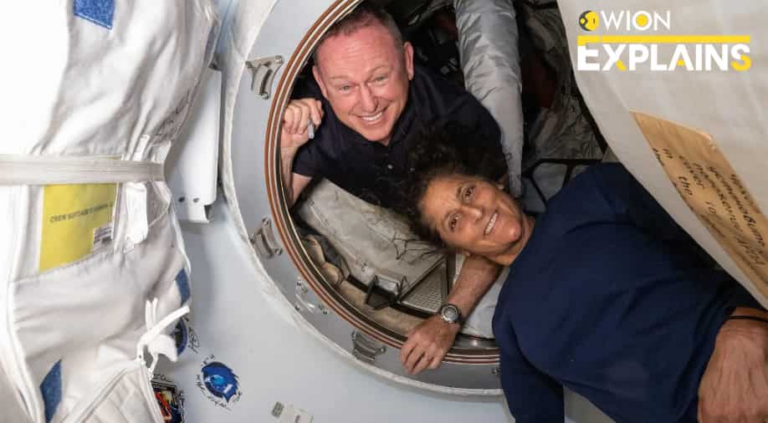
[ad_1]
The problematic Boeing Starliner craft, supposed to return to Earth this weekend, has started emitting ‘strange noises’ while in space. This supposed anomaly was observed and notified by veteran NASA Astronaut and Starliner crew member Butch Wilmore, who flew on the craft along with Sunita Williams.
Starliner, Boeing’s under-development astronaut ferry, has been plagued with multiple issues. Owing to the risks involved, this very craft which ferried Williams and Wilmore, would be returning to earth on auto-pilot, without the duo. The American astronaut duo are to return on a SpaceX Crew Dragon Craft, sometime in February 2025, thereby extending their eight-day mission to eight months.
This noise, which emanated from Starliner’s speakers has given rise to wild speculations and technical debates on the likely causes. From alien theories to ghost stories, sarcastic comments at Boeing, a few technical explanations, and a whole lot of theories are doing the rounds on social media.
What’s the Starliner ‘noise’ all about?
Over the last three months, there’s been a lot of trouble with Boeing’s Starliner spacecraft and it’s been creating a buzz on the news and social media. However, what’s cropped up now is literally ‘noise’.
This weekend, from aboard the Starliner that’s docked to the International Space Station, Butch Wilmore radioed the Mission Control at NASA”s Johnson Space Center, Houston: “I’ve got a question about Starliner. There’s a strange noise coming through the speaker. I don’t know what’s making it.”
Wilmore, while aboard the Starliner, is known to have made three attempts to relay the ‘strange audio’ to his ground controllers. The pinging noise was clearly captured on two of those attempts and the ground teams were heard acknowledging the same over the radio. A short audio clip of this conversation between Wilmore and Mission Control was made available online by Rob Dale, a Michigan-based meteorologist.
“Alright Butch, that one came through…” Mission control can be heard telling Wilmore. “It was kind of like a pulsing noise, almost like a sonar ping,” they added. Some social media users pointed out that the sound resembled that of banging against a metallic surface.
Are such ‘strange noises’ unprecedented ?
More than two decades ago, during China’s maiden astronaut mission, lone Taikonaut Yang Liwei heard strange sounds while in his spacecraft. “Knocking an iron bucket with a wooden hammer,” that’s how he had described his experience from the year 2003.
It was later learnt that the sound comes from tiny deformations in the space capsule’s inner wall materials due to changes in pressure. “A change of capsule temperature would cause a change in air pressure, and the difference in pressure between the inner and outer walls of the capsule caused tiny deformations of the wall materials, producing the sound Dong! Dong! Dong!,” it was revealed by Chinese researchers and spacecraft designers.
How dangerous and worrisome are these noises?
Unlike the Chinese mission, the Starliner’s ‘strange noise’ phenomenon is known to be emanating from the speakers, and not the spacecraft’s body. Therefore, on the face of it, it appears not so worrisome. However, given the poor track record of Starliner and the saga that has been dragging on, anything is possible!
“There are several noises I’d prefer not to hear inside my spaceship, including this one that @Boeing Starliner is now making,” veteran Canadian astronaut Chris Hadfield said in a social media post.
This further adds to the reputational damage that Boeing has been suffering – for its vehicles that ply on earth and outside of earth.
Radio Frequency Interference or Audio Feedback
Radio Frequency Interference (RFI) is a type of electromagnetic interference (EMI) that occurs when unwanted radio frequency signals disrupt the normal operation of electronic devices. This interference can be caused by various sources, both natural and human-made. Mobile phones, Bluetooth devices, microwave ovens, Wi-fi routers, and a plethora of other devices can cause some kind of RFI.
At the 400 km height at which the Space Station and the Starliner orbits, there are several satellites above and below, and there are multiple ground-based antennae sending signals to space. Radio frequency interference is among the likely scenarios when considering that the ‘strange audio’ has emanated from a speaker.
Audio feedback, often heard as a high-pitched screeching sound, occurs when a microphone picks up sound from a speaker and re-amplifies it, creating a continuous and disturbing loop. This could be caused when a microphone is placed too close to a speaker when there are reflective surfaces that bounce sound back into the mic, or even when the mic and speaker are at high volume.
[ad_2]